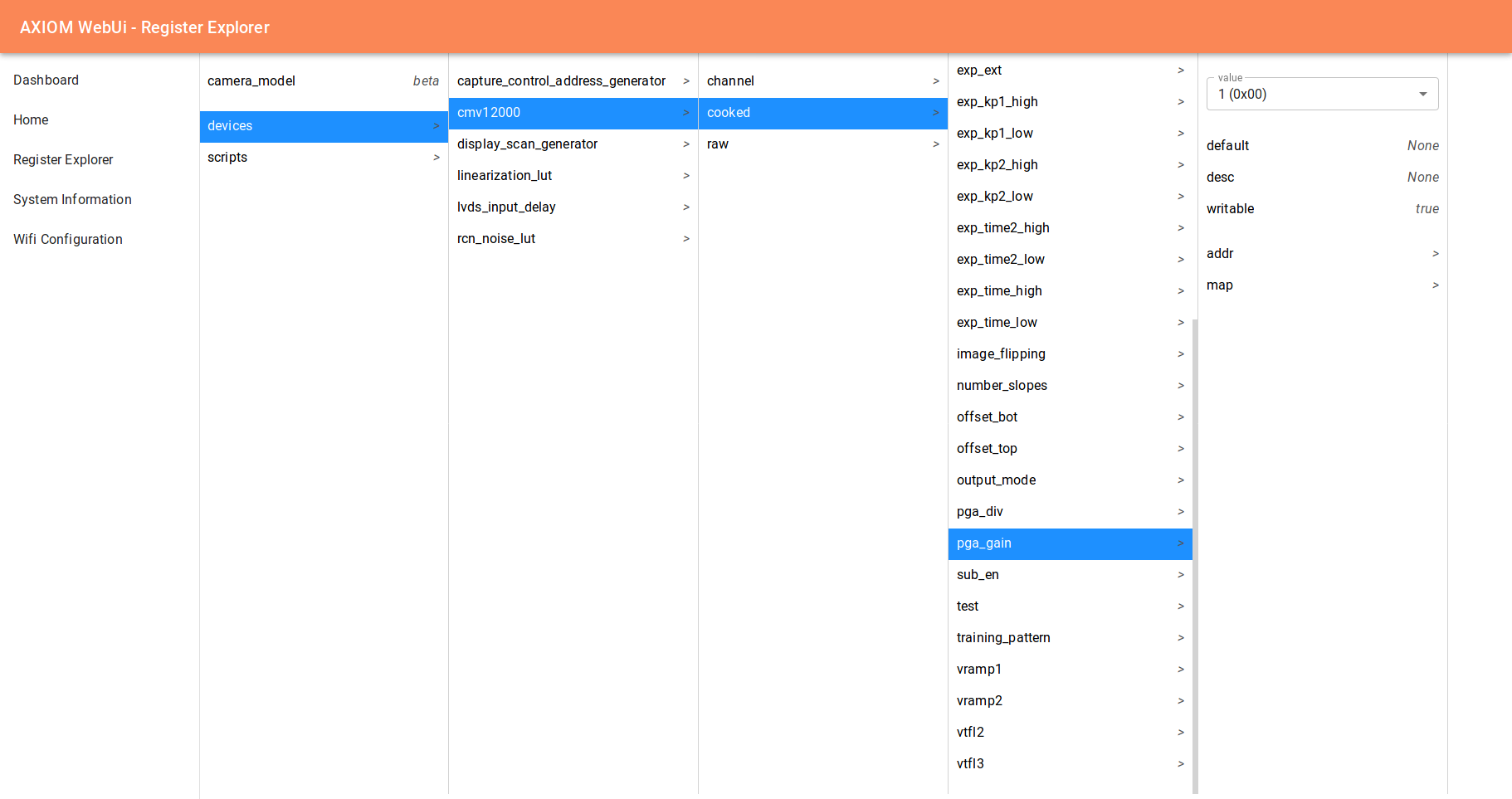AXIOM ctrl
A driver for controlling AXIOM cameras.
Working Principle
The code in this repository takes care of all the low level communication to the hardware
of the camera (ie. the image sensor). This is done with a variety of protocols (ie. i2c
or memory access to shared memory regions with the FPGA).
Similar to a Linux kernel driver, a filesystem hierarchy is exposed, which represents the different parameters of the hardware.
Exposing the parameters as a filesystem allows for simple solutions for a wide veriety of use cases:
- Write/ Read single parameters:
$ cat /axiom_api/devices/cmv12000/cooked/pga_gain/value 1 $ echo -n "2" > /axiom_api/devices/cmv12000/cooked/pga_gain/value # sets the analog gain to 2×
- List available parameters:
$ ls /axiom_api/devices/cmv12000/cooked/ pga_gain pga_div ...
- Get information about parameters:
$ cat /axiom_api/devices/cmv12000/cooked/pga_gain/description analog gain
This simple abstraction allows to easily create powerful tools that build upon ctrl, like the register explorer of the webui.
No Kernel Space Code
However, no kernel code is needed to expose the outlined functionality and FUSE is used
to implement the filesystem. This gives better debuggability and allows us to code
rust instead of kernel style C at the cost of some performance penalty and loosing the ability to handle
interrupts.
Developing locally
$ mkdir ./axiom_api
$ cargo run -- --mock --mountpoint ./axiom_api camera_descriptions/beta/beta.ymlConcepts
The control daemon parses a YAML file that describes the camera setup and the available devices. A device consist of four parts:
- A communication channel, that specifies how registers are read and written. This can for example be a memory mapped region or a i2c device. The different communication channels are implemented in rust and the configuration file specifies the necessary parameters. For example
channel: mode: "i2c-cdev" bus: 0 address: 0x10
- Raw registers, that assign a address a name and potentially some metadata like the width of the register, a description, min and max values or a default.
temp_sensor: address: 127 width: 2 default: 0 description: > Read-Only. Contains a value for calculating the sensor temperature.
- Cooked registers, that assign a bit slice of a raw register or a address a name, metadata like the raw registers and potentially a value map. This map can map the raw register values to either floats, ints or strings. If such a map is present, reading a cooked register automatically returns the value assigned by the map and writing to such a register converts the given value to the raw value using this map. For example:
This assigns a raw value of 0 the cooked value 1, the raw value 1 the cooked value 2 and so forth. Writing 4 to this register would write 7 to the first three bits of the raw register
pga_gain: address: pga[0:3] description: analog gain map: 0: 1 1: 2 3: 3 7: 4
pga. If the first three bits of the raw registerpgacontain the value 1 reading this register would return 2. - Computed registers, that allow for arbitrary lua scripts to read and write a combination of registers. This could for example be used to provide a way to directly set a ISO value, which then sets a combination of digital gain, analog gain and potentially other registers. For example:
This would provide a computed register for setting and reading the analog gain on the
analog_gain: description: "Sets the analog gain" type: float get: return cooked.coarse_gain * cooked.fine_gain set: > local coarse = math.floor(value) local fine = value / coarse cooked.coarse_gain = coarse cooked.fine_gain = fine
ar0330image sensor.
The last part of a camera are scripts, which are a series of arbitrary register (raw, cooked or computed) operations. Using scripts allows to prevent any register accesses / writes by others between two different register operations. For example when starting up a image sensor a series of different registers writes of different devices is often necessary, which should not be interrupted by register accesses / writes by others. Currently scripts can only be written in rust, but support for lua scripts is planned. A rust script to start the ar0330 image sensor in default settings on the micro-r2 can be found here
